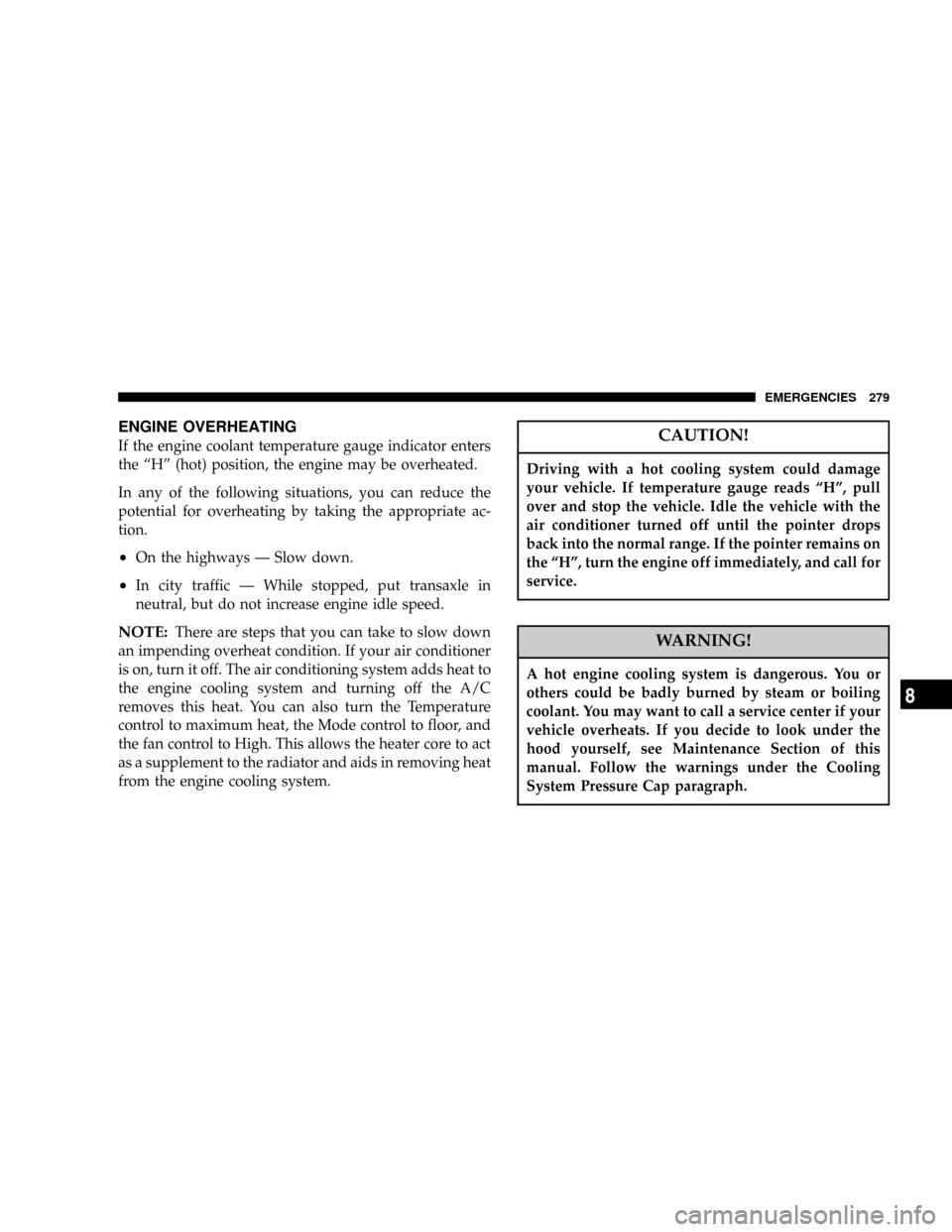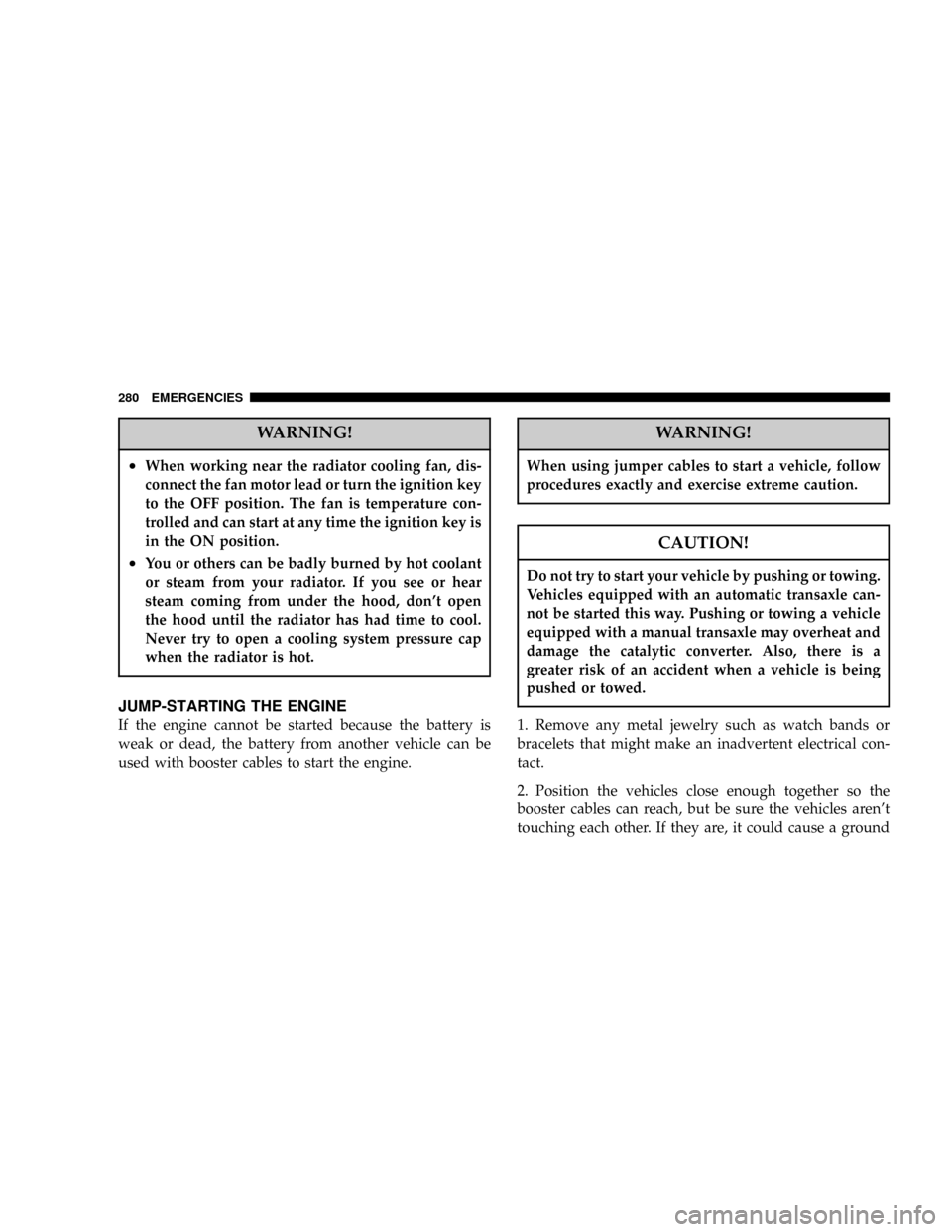2005 DODGE STRATUS COUPE engine overheat
[x] Cancel search: engine overheatPage 201 of 396

8. Stop driving the vehicle if you think the performance
is noticeably less, or that there is unnecessary engine
miss, or any other engine trouble, such as with the
ignition, etc. If it is impractical to stop driving immedi-
ately, reduce the speed and drive for only a short time.
Have an inspection made by an authorized dealer as
soon as possible.
9. In an unusual event of a severe engine malfunction, a
scorching odor may indicate severe and abnormal cata-
lytic converter overheating. If this occurs, the vehicle
should be stopped in a safe place, the engine shut off and
the vehicle allowed to cool. Once the engine is cool, the
vehicle should immediately be taken to a dealer for
service.
VEHICLE PREPARATION BEFORE DRIVING
Before starting on a trip, perform the following checks to
obtain the greatest possible enjoyment and safety from
your vehicle:
Seat belts and seats
1. Before starting the vehicle, make certain that you and
all your passengers are seated and properly wearing the
seat belts (with children in the rear seat, in appropriate
restraints), and that all doors are locked.
2.
Adjust the driver's seat as far back as possible, while still
maintaining good visibility, and good control of the steering
wheel, brakes, accelerator, and controls. Examine the instru-
ment panel indicators for any possible malfunction.
3. Have the front passenger adjust their seat as far
rearward as possible.
Defrosters
Check operation by selecting the defroster mode and set
the blower switch for high speed operation. You should
be able to feel the air directed against the windshield.
(See ªHeater /Air conditioningº page 238.)
Tires
Examine all tires for excessive tread wear or uneven wear
patterns. Check for stones, nails, glass, or other objects
lodged in the tread. Inspect for tread cuts or sidewall
cracks.
STARTING AND DRIVING 201
5
Page 204 of 396

over curbs or parking stop blocks. Always use caution
when traveling up or down sharp inclines as your
bumper may contact the road surface.
2. Maintain specified tire inflation pressures. Replace
tires before they are excessively worn.
3. If you plan to drive in another country, comply with
the vehicle registration laws and confirm the availability
of the correct fuel.
OPERATION DURING COLD WEATHER
1. Check the battery, including terminals and cables.
During extremely cold weather, the battery capacity will
decrease. Also, the battery power level may drop because
more power is needed for cold starting and operation.
Before driving the vehicle, check to see if the engine runs
at the proper speed and if the headlights are at their usual
intensity. Charge or replace the battery if necessary.
During cold weather, it is possible that a discharged
battery could freeze.
WARNING!
The battery gives off explosive hydrogen gas. Any
spark or flame can cause the battery to explode,
which could seriously injury or kill you.
Always wear protective clothes and a face shield
when doing battery maintenance, or let a skilled
technician do it.
2. Manual transaxles may be more difficult to shift
during cold weather operation. This is normal and shift
effort will become easier as the transaxle reaches a
normal operating temperature.
Maintain low-speed operation at first to allow the trans-
axle oil to be distributed to all lubrication points.
3. Check the engine antifreeze.
If there is a shortage of coolant due to leakage or engine
overheating, add high-quality ethylene glycol antifreeze
and water. The recommended ratio is about 50% water
and 50% anti-freeze. This ratio provides adequate corro-
sion, boiling, and freeze protection.
204 STARTING AND DRIVING
Page 261 of 396

EMERGENCIES
CONTENTS
mIf the vehicle breaks down................263
NIf the engine quits.....................263
mOperation under adverse driving conditions...263
NIf your vehicle becomes stuck in sand, mud or
snow..............................263
NOnawetroad........................264
NOn snowy or icy roads..................265
mSpare tire, jack and tool set storage.........266
NHandling spare tire....................266
NJack...............................267
mCompact spare tire.....................267
mWheel covers (if so equipped).............268
mJacking and tire changing................270
NJacking up the vehicle..................270
mEngine overheating.....................279
mJump-starting the engine.................280
NIf your vehicle has anti-lock brakes.........284
mTowing..............................284
mFuses...............................286
NFuse block...........................287
mFusible links..........................287
NFuse load capacities....................288
mReplacement of light bulbs................293
NBulb capacity.........................293
8
Page 263 of 396

IF THE VEHICLE BREAKS DOWN
If the vehicle breaks down on the road, move to the
shoulder and activate the hazard warning flashers. If
there is no shoulder, or the shoulder is not safe, drive in
the right lane, slowly, with the hazard flashers activated,
until you reach a safe place to stop. Keep the flashers
activated.
If the engine quits
If the engine stops, power will be lost to the steering and
brakes, making steering and braking difficult.
1. The brake booster becomes inoperative and the brake
pedal will be harder to push than usual.
2. Since power steering system is not operative, the
steering wheel will be stiff when turning. Turn the wheel
with more effort than usual.
OPERATION UNDER ADVERSE DRIVING
CONDITIONS
If your vehicle becomes stuck in sand, mud or
snow
If the vehicle becomes stuck in snow, sand, or mud, it can
often be moved by a rocking motion. Turn your steering
wheel right and left to clear the area around the wheels.
Move the gearshift lever or selector lever rhythmically
between the 1st and REVERSE position (with manual
transaxle), ``L'' (Low) and ``R'' (REVERSE) position (with
automatic transaxle), Autostick and ``R'' (REVERSE posi-
tion (with automatic transaxle autostick), while applying
slight pressure to the accelerator pedal.
Avoid racing the engine or spinning the wheels. Pro-
longed efforts to free a stuck vehicle may result in
overheating and transaxle failure.
Allow the engine to idle for a few minutes to let the
transaxle cool between rocking attempts.
If the vehicle remains stuck after several rocking at-
tempts, seek other assistance.
EMERGENCIES 263
8
Page 279 of 396

ENGINE OVERHEATING
If the engine coolant temperature gauge indicator enters
the ªHº (hot) position, the engine may be overheated.
In any of the following situations, you can reduce the
potential for overheating by taking the appropriate ac-
tion.
²On the highways Ð Slow down.
²In city traffic Ð While stopped, put transaxle in
neutral, but do not increase engine idle speed.
NOTE:There are steps that you can take to slow down
an impending overheat condition. If your air conditioner
is on, turn it off. The air conditioning system adds heat to
the engine cooling system and turning off the A/C
removes this heat. You can also turn the Temperature
control to maximum heat, the Mode control to floor, and
the fan control to High. This allows the heater core to act
as a supplement to the radiator and aids in removing heat
from the engine cooling system.
CAUTION!
Driving with a hot cooling system could damage
your vehicle. If temperature gauge reads ªHº, pull
over and stop the vehicle. Idle the vehicle with the
air conditioner turned off until the pointer drops
back into the normal range. If the pointer remains on
the ªHº, turn the engine off immediately, and call for
service.
WARNING!
A hot engine cooling system is dangerous. You or
others could be badly burned by steam or boiling
coolant. You may want to call a service center if your
vehicle overheats. If you decide to look under the
hood yourself, see Maintenance Section of this
manual. Follow the warnings under the Cooling
System Pressure Cap paragraph.
EMERGENCIES 279
8
Page 280 of 396

WARNING!
²When working near the radiator cooling fan, dis-
connect the fan motor lead or turn the ignition key
to the OFF position. The fan is temperature con-
trolled and can start at any time the ignition key is
in the ON position.
²You or others can be badly burned by hot coolant
or steam from your radiator. If you see or hear
steam coming from under the hood, don't open
the hood until the radiator has had time to cool.
Never try to open a cooling system pressure cap
when the radiator is hot.
JUMP-STARTING THE ENGINE
If the engine cannot be started because the battery is
weak or dead, the battery from another vehicle can be
used with booster cables to start the engine.
WARNING!
When using jumper cables to start a vehicle, follow
procedures exactly and exercise extreme caution.
CAUTION!
Do not try to start your vehicle by pushing or towing.
Vehicles equipped with an automatic transaxle can-
not be started this way. Pushing or towing a vehicle
equipped with a manual transaxle may overheat and
damage the catalytic converter. Also, there is a
greater risk of an accident when a vehicle is being
pushed or towed.
1. Remove any metal jewelry such as watch bands or
bracelets that might make an inadvertent electrical con-
tact.
2. Position the vehicles close enough together so the
booster cables can reach, but be sure the vehicles aren't
touching each other. If they are, it could cause a ground
280 EMERGENCIES
Page 328 of 396

WARNING!
²Never disconnect the battery while the engine is
running; doing so could damage the vehicle's
electrical components.
²Never short-circuit the battery; doing so could
cause it to overheat and be damaged.
²Keep sparks, cigarettes and flames away from the
battery because the battery may produce an explo-
sion.
²Electrolyte (battery acid) is corrosive diluted sul-
furic acid. If electrolyte comes in contact with,
your hands, eyes, clothes, or the coated surface of
your vehicle, thoroughly flush the area with wa-
ter. If electrolyte gets in your eyes, flush them
with water immediately and get prompt medical
attention.
WARNING!
²Ventilate the area when charging or using the
battery in an enclosed space.
²Always wear protective clothing and goggles
when working with the battery, or have a skilled
technician do it.
²If the battery is to be quick-charged, first discon-
nect the battery cables from the vehicle.
²In order to prevent a short circuit, be sure to
disconnect the negative(-) terminal first, and re-
connect it last.
²If the electrolyte level is very low, have the battery
checked at an authorized dealer.
²Battery posts, terminals and related accessories
contain lead and lead compounds. Wash hands
after handling.
328 MAINTENANCE
Page 392 of 396

Engine coolant......................... 322
Engine coolant level warning light.......... 109
Engine coolant temperature gauge.......108,113
Engine hood release...................... 42
Engine oil and oil filter.................. 318
Engine overheating..................... 279
Engine serial number.................... 373
Engine specifications.................... 377
Exhaust system.....................332,377
Fluid
Automatic transaxle fluid............... 329
Brake fluid.......................... 323
Clutch fluid......................... 324
Fog light switch........................ 125
Front fog lamp indicator lamp............. 116
Front seat adjustment..................... 57
Fuel
Filler Cap........................... 150
Fuel economy........................ 151
Fuel filler............................ 39
Fuel gauge.......................108,111
Fuel hoses.......................... 315Fuel selection........................ 146
Low-fuel warning light..............109,115
Fuses................................ 286
Fusible links.......................... 287
Garage Door Opener.................... 134
GasCap .............................. 150
Gasoline/Oxygenate Blends............... 148
Gauges.........................108,111,113
Gear positions......................... 158
General maintenance
Maintenance service................... 318
General vehicle data..................... 375
Glove compartment..................215,216
Handling of Compact Discs............... 234
Hazard warning flasher switch............. 126
Hazard warning light.................109,114
Head restraints......................... 66
Headlights (Type 1)..................... 295
Headlights
Aiming............................. 297
Dimmer............................ 124
392 INDEX